![]()
![]()
![]()
Use LEFT and RIGHT arrow keys to navigate between flashcards;
Use UP and DOWN arrow keys to flip the card;
H to show hint;
A reads text to speech;
18 Cards in this Set
- Front
- Back
|
Athenian Red-Figure Kylix c. 480 BC Attributed to Foundry Painter |
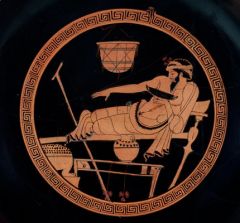
|
|
|
Hydria c. 700BC, Analatos painterWater carrier. Figures are more fluidly drawn. Not an entire break from the geometric style however. |
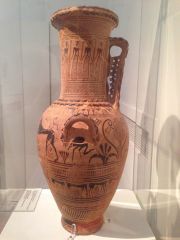
|
|
|
Eleusis Amphora, Attic, c. 660 Odysseus & Polyphemos; Gorgons & PerseusSynoptic technique Neck: Odysseus blinding Polyphemos How does one image cast light on the other?Solid and outline used for the lion, filling ornament on shoulder of vase |
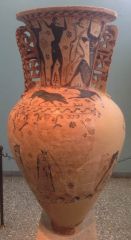
|
|
|
New York Nessos Amphora, c. 650 Heracles, Nessos, Deianeira Large collapsingfigure of the centaur, human legs at front, hair flailing behind him, gestureof movement.Black body forcentaur as well as outline. Series of images that goes all the way around the vase.Generic decorationon one side. Running man… Filling in space forus convenientlyMain narrative mostof the way, and then a visual similae. Wild hair almostalways a sign of being a bad guy.Eagle: Zeus. Ideathat this happens with the approval of Zeus, Herakles son of Zeus. Herakles about todispatch this dude with a sword. rW |
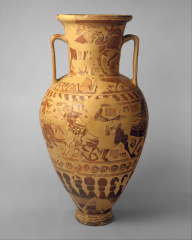
|
|
|
New York Kouros, Attic, c. 610 |
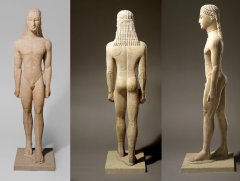
|
|
|
Tenea Kouros, c. 560-50 |
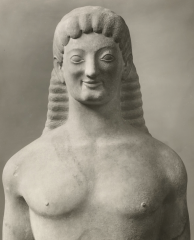
|
|
|
Anavysos Kouros, Attic, c. 530 |
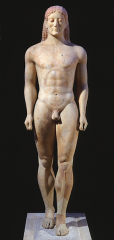
|
|
|
Piraeus Kouros (‘Apollo’), c. 520 |
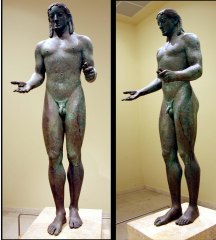
|
|
|
Berlin Kore, Attic, c. 590 Stiff and static looking. Folds of peplos emphasize her verticality. Brightly painted once upon a time. Necklace, headpiece, all things are signs of aristocratic status. |
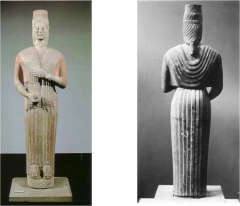
|
|
|
Phrasikleia, Merenda, c. 540 By Aristion of Paros Sculptor is naming himself, sense of pride and competition. This woman has died, funeral marker. Holding a lotus flower. Blokes have arms down by sides most of the time, but the women are doing something. Aristocratic girls probably got married at about 15 years old, marrying men twice their age. Homeric hymn to Demeter, when Persephone consumes the seed given by Hades, stays in the underworld for 4 months, sexual reference. Fruit now associated with sex |

|
|
|
Peplos Kore, Attic, c. 530 Maidens are holding something out. Certain ambiguity in the gesture. Readiness to embark on a life of sexual activity by holding the apple out, whether she is receiving or giving the apple. |
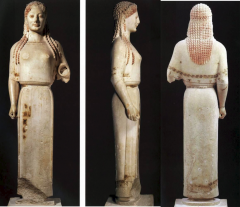
|
|
|
Lydos, column krater, c. 560 Dionysus in the middle, column like handles. |
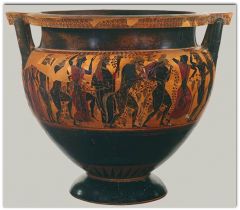
|
|
|
Exekias, neck amphora, c. 540 Achilles and Penthesileia |
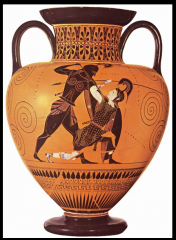
|
|
|
Exekias, neck amphora, c. 540 Achilles and ajax playing drafts |

|
|
|
Exekias, kylix ‘eye cup’, c. 540 Hold it up and it covers your face, becomes possessed by Dionysus, because Dionysus himself is sometimes personified as wine. |
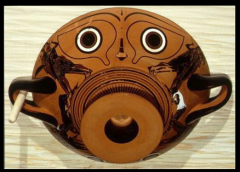
|
|
|
Exekias, belly amphora, c. 530 |

|
|
|
Berlin Painter, amphora, c. 490 Figures more lean. Hermes and Satyr Different brush strokes for pecks of satyr. Subtle musculature. Different brush use for hair. Nice blurring between figures, Dionysus there in spirit? Who is holding what? Ambiguity that Dionysus gives you.Enlarged eye. Sense of madness simmering under surface. |
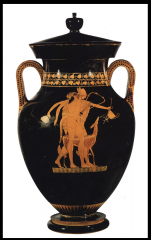
|
|
|
Athenian Red-Figure Neck-AmphoraAtrributed to the Hermonax Painter, 470-460 BC On side A we see Zeus wearing a wreath and cloak, leaning on his scepter, and holding a phiale. A phiale was vessel used in ancient Greek religious ceremonies to pour libations of oil to the gods. Facing him is a woman, thought to be Zeus’s daughter Hebe, carrying an oinochoe or a jug. This is a quiet scene between father and daughter.On Side B is a cloaked man with a wreath in his hair, standing with his right hand outstretched as if in greeting. This figure may also be Zeus. |
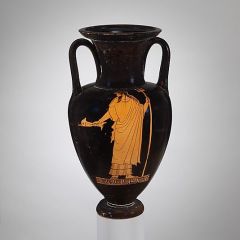
|

